 Wow! What a year 2022 was for books. I read more great books this past year than I have in the past two or three years combined. I continued reading more nonfiction than I have in the past (with the exception of 2021), but I also had the great good fortune to spend time with terrific works of fiction. From a reading perspective, 2022 was a great year!
Wow! What a year 2022 was for books. I read more great books this past year than I have in the past two or three years combined. I continued reading more nonfiction than I have in the past (with the exception of 2021), but I also had the great good fortune to spend time with terrific works of fiction. From a reading perspective, 2022 was a great year!
Although it’s a good problem to have, after reading so many good books, some really terrific books didn’t make the top 10 list. For instance, there were five books I read in 2022 that just missed this year’s top 10, but which would have easily made the list in any other year. Those books (in alphabetical order) are:
- How Civil Wars Start by Barbara Walter
- Love Until Death by Mark Seal
- Miracle and Wonder by Malcolm Gladwell
- Survival of the Fastest by Randy Lanier
- They Knew by Sarah Kendzior
All five of these books were terrific, and there’s a part of me that feels guilty for not including them in my top 10. Of course, that means that the books that did make the top 10 were exceptional. Here they are:
!0. 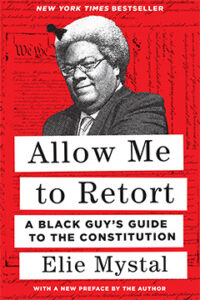 Allow Me to Retort: A Black Guy’s Guide to the Constitution by Elie Mystal — Americans–particularly white Americans–take a lot for granted when it comes to the Constitution. We’ve been taught things about what different parts of the Constitution mean, and that has become common knowledge. And often, that common knowledge is wrong. Mystal does a great job of explaining the history of the Constitution in clear, easily digestible language, and then goes on to show how what we believe about the Constitution today is simply wrong. In fact, in many cases, what we believe about the Constitution is often unconstitutional (i.e., not in compliance with the Constitution). Throughout the book, Mystal is not only informative, but entertaining and often righteously indignant. The title of the book might lead readers to believe this is a book for black Americans, but it’s a book that should be read by all Americans who care about the history of the Constitutional and the truth of its meaning.
Allow Me to Retort: A Black Guy’s Guide to the Constitution by Elie Mystal — Americans–particularly white Americans–take a lot for granted when it comes to the Constitution. We’ve been taught things about what different parts of the Constitution mean, and that has become common knowledge. And often, that common knowledge is wrong. Mystal does a great job of explaining the history of the Constitution in clear, easily digestible language, and then goes on to show how what we believe about the Constitution today is simply wrong. In fact, in many cases, what we believe about the Constitution is often unconstitutional (i.e., not in compliance with the Constitution). Throughout the book, Mystal is not only informative, but entertaining and often righteously indignant. The title of the book might lead readers to believe this is a book for black Americans, but it’s a book that should be read by all Americans who care about the history of the Constitutional and the truth of its meaning.
9. 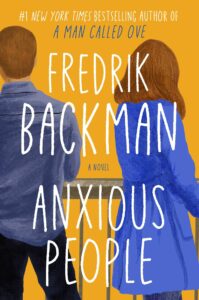 Anxious People by Fredrik Backman — I tend to be a realist. If a story takes place in the real world (as opposed to a sci-fi created world), I expect things to make sense. People should act the way people act in the real world, which usually means, they should act in their own best interest (If you’ve never heard my rant about the implausibility of the novel Gone Girl, you don’t know what you’re missing). Anxious People breaks this rule. Even so, I’m okay with it. Backman has a way of creating characters that the reader comes to care about so deeply, that they accept just about anything the character does, even if their behavior is unlikely. So, when an otherwise law-abiding citizen decides to rob a bank and the police investigating the crime choose to overlook the criminal behavior, what is a realist to do? In the hands of a master like Fredrik Backman, even a realist like me can accept the unlikely behavior. Why? It’s the characters. With Backman, it’s always the characters.
Anxious People by Fredrik Backman — I tend to be a realist. If a story takes place in the real world (as opposed to a sci-fi created world), I expect things to make sense. People should act the way people act in the real world, which usually means, they should act in their own best interest (If you’ve never heard my rant about the implausibility of the novel Gone Girl, you don’t know what you’re missing). Anxious People breaks this rule. Even so, I’m okay with it. Backman has a way of creating characters that the reader comes to care about so deeply, that they accept just about anything the character does, even if their behavior is unlikely. So, when an otherwise law-abiding citizen decides to rob a bank and the police investigating the crime choose to overlook the criminal behavior, what is a realist to do? In the hands of a master like Fredrik Backman, even a realist like me can accept the unlikely behavior. Why? It’s the characters. With Backman, it’s always the characters.
8.  The Braindead Megaphone by George Saunders — George Saunders is the best short story writer of his generation. But he’s not limited to short stories. In 2018, he published Lincoln in the Bardo, one of the finest novels I have ever read. The Braindead Megaphone is neither short stories nor novel. It is a book of essays. And true to Saunder’s form, it is brilliant. The Braindead Megaphone is not a new book. In fact, it was first published in 2007. Yet, much of what Saunders writes feels fresh and relevant today. Like all of Saunders’ writing, the essays are smart, witty, and exceptionally well written, with the unique Saunders’ voice. The essay that has stuck with me the longest is “Buddha Boy,” which was originally published in GQ Magazine. It is a travelogue of sorts, chronicling Saunder’s transcontinental journey to witness a meditating boy, purported to be the reincarnation of the Buddha. It is at once absurd, deeply spiritual, and steeped in the beauty of the human condition that Saunders brings to all of his writing.
The Braindead Megaphone by George Saunders — George Saunders is the best short story writer of his generation. But he’s not limited to short stories. In 2018, he published Lincoln in the Bardo, one of the finest novels I have ever read. The Braindead Megaphone is neither short stories nor novel. It is a book of essays. And true to Saunder’s form, it is brilliant. The Braindead Megaphone is not a new book. In fact, it was first published in 2007. Yet, much of what Saunders writes feels fresh and relevant today. Like all of Saunders’ writing, the essays are smart, witty, and exceptionally well written, with the unique Saunders’ voice. The essay that has stuck with me the longest is “Buddha Boy,” which was originally published in GQ Magazine. It is a travelogue of sorts, chronicling Saunder’s transcontinental journey to witness a meditating boy, purported to be the reincarnation of the Buddha. It is at once absurd, deeply spiritual, and steeped in the beauty of the human condition that Saunders brings to all of his writing.
7. 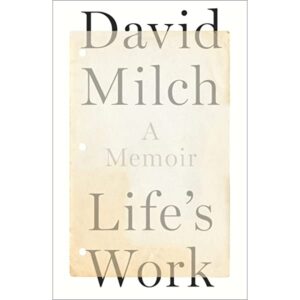 Life’s Work: A Memoir by David Milch — Back in 2019, I wrote a blog post listing my favorite TV shows of all time. The top two shows on that list (Spoiler Alert!) were Hill Street Blues and Deadwood. In fact, I loved Deadwood so much, that I wrote a two-part deep dive (Part 1 and Part 2) into the show. The one common denominator between Hill Street Blues and Deadwood: David Milch. Milch was a writer on Hill Street Blues, and he created and wrote Deadwood. Both were groundbreaking shows. Sadly, Deadwood ended after just three years. Milch had much more of the story he wanted to tell, but he couldn’t reach an agreement with HBO to continue. For ten years, viewers and Milch yearned to return to Deadwood, but the deal with HBO was dead, the show’s actors had moved on to other projects, and Milch himself, who was the driving force behind the show, was in failing health, having been diagnosed with Alzheimer’s. But in 2019, Milch was able to get the band back together to do a movie. It wasn’t a return to the series, but it was mighty good just the same. Throughout his career, Milch was a creative genius, as both a show creator and writer. But he was also troubled, struggling with alcohol and drugs. He made a lot of money, lost most of it, and always relied on the strength and loyalty of his wife and kids. In Life’s Work, Milch brings his raw, gritty, unflinching style to his most personal story; his own. It was sad knowing his life story would be the last story he would ever share with the public, but it was also satisfying hearing it from the man who lived it.
Life’s Work: A Memoir by David Milch — Back in 2019, I wrote a blog post listing my favorite TV shows of all time. The top two shows on that list (Spoiler Alert!) were Hill Street Blues and Deadwood. In fact, I loved Deadwood so much, that I wrote a two-part deep dive (Part 1 and Part 2) into the show. The one common denominator between Hill Street Blues and Deadwood: David Milch. Milch was a writer on Hill Street Blues, and he created and wrote Deadwood. Both were groundbreaking shows. Sadly, Deadwood ended after just three years. Milch had much more of the story he wanted to tell, but he couldn’t reach an agreement with HBO to continue. For ten years, viewers and Milch yearned to return to Deadwood, but the deal with HBO was dead, the show’s actors had moved on to other projects, and Milch himself, who was the driving force behind the show, was in failing health, having been diagnosed with Alzheimer’s. But in 2019, Milch was able to get the band back together to do a movie. It wasn’t a return to the series, but it was mighty good just the same. Throughout his career, Milch was a creative genius, as both a show creator and writer. But he was also troubled, struggling with alcohol and drugs. He made a lot of money, lost most of it, and always relied on the strength and loyalty of his wife and kids. In Life’s Work, Milch brings his raw, gritty, unflinching style to his most personal story; his own. It was sad knowing his life story would be the last story he would ever share with the public, but it was also satisfying hearing it from the man who lived it.
6. 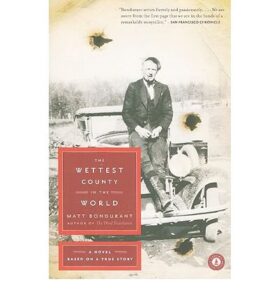 The Wettest County in the World by Matt Bondurant –In literary circles, Matt Bondurant is well known. His books have won several prizes and have been made into movies. He teaches creative writing at the University of Mississippi. I knew of Bondurant, but I had never read his writing until this past year. I’m glad I did. It’s an overused cliché to refer to literary writing as “rich” or “lush,” but that’s exactly what Bondurant’s writing is. It surrounds the readers, enveloping and engrossing them. In The Wettest County in the World (a moniker given to Franklin County, VA by famed writer Sherwood Anderson), Bondurant tells the true story of his grandfather and two grand uncles, all notorious moonshiners and tough guys in prohibition-era Virginia. The three men lived outside the law, protecting what was theirs with their fists and, when necessary, with guns. The Wettest County in the World was made into a movie (entitled Lawless) starring Shia Lebeouf, Tom Hardy, and Jessica Chastain. I’ve never seen the movie, but if it’s half as good as the book, it would be worth watching.
The Wettest County in the World by Matt Bondurant –In literary circles, Matt Bondurant is well known. His books have won several prizes and have been made into movies. He teaches creative writing at the University of Mississippi. I knew of Bondurant, but I had never read his writing until this past year. I’m glad I did. It’s an overused cliché to refer to literary writing as “rich” or “lush,” but that’s exactly what Bondurant’s writing is. It surrounds the readers, enveloping and engrossing them. In The Wettest County in the World (a moniker given to Franklin County, VA by famed writer Sherwood Anderson), Bondurant tells the true story of his grandfather and two grand uncles, all notorious moonshiners and tough guys in prohibition-era Virginia. The three men lived outside the law, protecting what was theirs with their fists and, when necessary, with guns. The Wettest County in the World was made into a movie (entitled Lawless) starring Shia Lebeouf, Tom Hardy, and Jessica Chastain. I’ve never seen the movie, but if it’s half as good as the book, it would be worth watching.
5. 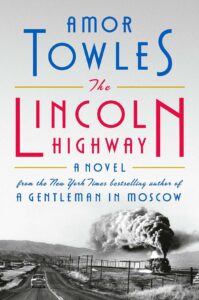 The Lincoln Highway by Amor Towles — In my 2021 list of the ten best books I had read, I commented that Amor Towles’ A Gentleman in Moscow may be the best written book I had ever had the pleasure of reading. I went on to say that Towles plot, despite being so well written, was plodding and uninspiring. In The Lincoln Highway, Towles writing isn’t quite as brilliant (it’s still really good), but his plot is better. The story takes place in mid-1950’s Nebraska. Emmett Watson returns home from a juvenile work camp to his family’s empty farm. His mother ran off years before, and his father has died. His precocious younger brother, Billy, who worships Emmett, is living with the neighbors. To Emmett’s surprise, two of his pals from the work farm have escaped and joined him in Nebraska. Their appearance derails Emmett’s plans and sends him and Billy off on a cross-country adventure. They want to go to California to find their mother, but instead end up in New York City. Along the way, they meet interesting characters, suffer indignities, and experience the expansion of the nation along the Lincoln Highway.
The Lincoln Highway by Amor Towles — In my 2021 list of the ten best books I had read, I commented that Amor Towles’ A Gentleman in Moscow may be the best written book I had ever had the pleasure of reading. I went on to say that Towles plot, despite being so well written, was plodding and uninspiring. In The Lincoln Highway, Towles writing isn’t quite as brilliant (it’s still really good), but his plot is better. The story takes place in mid-1950’s Nebraska. Emmett Watson returns home from a juvenile work camp to his family’s empty farm. His mother ran off years before, and his father has died. His precocious younger brother, Billy, who worships Emmett, is living with the neighbors. To Emmett’s surprise, two of his pals from the work farm have escaped and joined him in Nebraska. Their appearance derails Emmett’s plans and sends him and Billy off on a cross-country adventure. They want to go to California to find their mother, but instead end up in New York City. Along the way, they meet interesting characters, suffer indignities, and experience the expansion of the nation along the Lincoln Highway.
4. 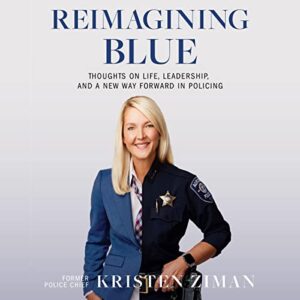 Reimagining Blue: Thoughts on Life, Leadership, and a New Way Forward in Policing by Kristen Ziman — Kristen Ziman and I share a couple things in common. First, we were both born and raised in Aurora, IL. When we graduated from high school–me 13 years earlier than Kristen–we both joined the Aurora Police Department. I decided I really didn’t want a life as a cop. Kristen went the other direction, becoming a patrol officer, moving into leadership, and eventually becoming Chief of Police in Aurora. I wrote a complete book review of Reimagining Blue previously, so I won’t re-do that here. Instead, I’ll simply say that Ziman’s book caught me off-guard. I did not expect to be so entertained or inspired by her stories. Neither did I expect to be so impressed with her writing. Reimagining Blue is part history, part memoir, and part treatise on leadership. It is also a deep and badly needed look at policing in America. Ziman is unapologetic in her support of local law enforcement, but she refuses to turn a blind eye to the corruption and bad behavior that plagues many departments across the country. She believes that law enforcement plays an important and noble role in our society, but thinks we are getting it wrong when police departments take actions to separate themselves from the communities they are sworn to serve and protect, rather than enmesh themselves within those communities. Reimagining Blue is both an entertaining read as well as an invaluable resource when it comes to American law enforcement.
Reimagining Blue: Thoughts on Life, Leadership, and a New Way Forward in Policing by Kristen Ziman — Kristen Ziman and I share a couple things in common. First, we were both born and raised in Aurora, IL. When we graduated from high school–me 13 years earlier than Kristen–we both joined the Aurora Police Department. I decided I really didn’t want a life as a cop. Kristen went the other direction, becoming a patrol officer, moving into leadership, and eventually becoming Chief of Police in Aurora. I wrote a complete book review of Reimagining Blue previously, so I won’t re-do that here. Instead, I’ll simply say that Ziman’s book caught me off-guard. I did not expect to be so entertained or inspired by her stories. Neither did I expect to be so impressed with her writing. Reimagining Blue is part history, part memoir, and part treatise on leadership. It is also a deep and badly needed look at policing in America. Ziman is unapologetic in her support of local law enforcement, but she refuses to turn a blind eye to the corruption and bad behavior that plagues many departments across the country. She believes that law enforcement plays an important and noble role in our society, but thinks we are getting it wrong when police departments take actions to separate themselves from the communities they are sworn to serve and protect, rather than enmesh themselves within those communities. Reimagining Blue is both an entertaining read as well as an invaluable resource when it comes to American law enforcement.
3.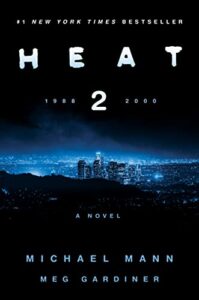 Heat 2 by Michael Mann — In 1995, Michael Mann wrote and directed the movie Heat, starring Robert De Niro, Al Pacino, Val Kilmer, and Amy Brenneman. It was a blockbuster and went on to earn more than $180 million. For years, ideas for a prequel or a sequel rolled around in Mann’s mind. He wanted something big that would be worthy of the success he experienced with Heat. But as time went on and the nature of big blockbusters changed, the opportunity to make a prequel or sequel to the film vanished. Instead of a film, Mann turned his attention to a book. And instead of choosing a prequel or a sequel, he chose both, all in one book. Reading Heat 2 is like watching a movie. Mann’s descriptions and characters are cinematic in nature. His dialogue evokes dialogue from a movie. I can’t fully explain it, but reading Heat 2 was a unique experience for me. Other books reminded me of a movie. Heat 2 was like watching a movie. It is fast-paced, switching between timelines, relentlessly moving the story forward. Heat 2 was a fun, non-stop thrill ride.
Heat 2 by Michael Mann — In 1995, Michael Mann wrote and directed the movie Heat, starring Robert De Niro, Al Pacino, Val Kilmer, and Amy Brenneman. It was a blockbuster and went on to earn more than $180 million. For years, ideas for a prequel or a sequel rolled around in Mann’s mind. He wanted something big that would be worthy of the success he experienced with Heat. But as time went on and the nature of big blockbusters changed, the opportunity to make a prequel or sequel to the film vanished. Instead of a film, Mann turned his attention to a book. And instead of choosing a prequel or a sequel, he chose both, all in one book. Reading Heat 2 is like watching a movie. Mann’s descriptions and characters are cinematic in nature. His dialogue evokes dialogue from a movie. I can’t fully explain it, but reading Heat 2 was a unique experience for me. Other books reminded me of a movie. Heat 2 was like watching a movie. It is fast-paced, switching between timelines, relentlessly moving the story forward. Heat 2 was a fun, non-stop thrill ride.
2. 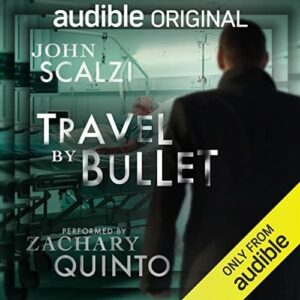 The Dispatcher/Murder by Other Means/Travel by Bullet by John Scalzi — Imagine this: The world is exactly as it is today, but suddenly, people cannot die at the hands of another human being. In other words, people still die from disease, including old age. They still die from suicide. They still die from car crashes and other types of accidents. But they can’t die at the hands of another human. If another human is the cause of a death, the victim disappears from the site of the murder and reappears, usually at home, naked, but otherwise uninjured. Imagine how that would change our world. That’s exactly what John Scalzi did in these three short novels. And in this new world, the government employs people called dispatchers who, in certain circumstances, are empowered to kill another human in the name of saving their life. For instance, let’s say a young woman is critically injured in an auto accident and is rushed to the hospital. Doctors agree they cannot save her. Or perhaps she’ll never walk again. In this case, a dispatcher is called in to end the young woman’s life. Once killed, the young woman will disappear from the hospital and reappear at home, in the same condition she was in six or ten hours previous. It’s an intriguing premise and one that takes a lot of twists and turns throughout Scalzi’s three books. I’m not sure if there will be a fourth book, but I’m hopeful.
The Dispatcher/Murder by Other Means/Travel by Bullet by John Scalzi — Imagine this: The world is exactly as it is today, but suddenly, people cannot die at the hands of another human being. In other words, people still die from disease, including old age. They still die from suicide. They still die from car crashes and other types of accidents. But they can’t die at the hands of another human. If another human is the cause of a death, the victim disappears from the site of the murder and reappears, usually at home, naked, but otherwise uninjured. Imagine how that would change our world. That’s exactly what John Scalzi did in these three short novels. And in this new world, the government employs people called dispatchers who, in certain circumstances, are empowered to kill another human in the name of saving their life. For instance, let’s say a young woman is critically injured in an auto accident and is rushed to the hospital. Doctors agree they cannot save her. Or perhaps she’ll never walk again. In this case, a dispatcher is called in to end the young woman’s life. Once killed, the young woman will disappear from the hospital and reappear at home, in the same condition she was in six or ten hours previous. It’s an intriguing premise and one that takes a lot of twists and turns throughout Scalzi’s three books. I’m not sure if there will be a fourth book, but I’m hopeful.
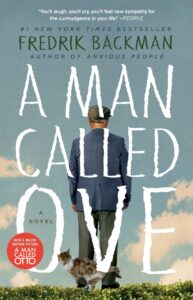 1. A Man Called Ove by Fredrik Backman — Everyone has heard of A Man Called Ove now that it has been made into a movie starring Tom Hanks (somewhat oddly retitled, A Man Called Otto). I hear the movie is good, but I seriously doubt that it is as good as the book. As I stated in my review for Anxious People (see above), Backman is a master at creating characters that find their way into the reader’s heart and wedge themselves there. Often, these characters start out as unlovable. Maybe they’ve made a mess of their lives, or in Ove’s case, they are grumpy beyond reason. He has built a metaphorical suit of armor around himself to repel any sort of human affection. Of course, as the suit comes down and the real Ove emerges, we are sucked in. We care about Ove. We want to see him make friends and open up to the world again. Despite whatever missteps or hardships he’s had in the past (in fact, precisely because of these missteps and hardships) we want him to win, to experience some good in his too dark and callous life. This is Backman’s formula, and it works time and time again. A Man Called Ove will melt the heart of even the most curmudgeonly reader.
1. A Man Called Ove by Fredrik Backman — Everyone has heard of A Man Called Ove now that it has been made into a movie starring Tom Hanks (somewhat oddly retitled, A Man Called Otto). I hear the movie is good, but I seriously doubt that it is as good as the book. As I stated in my review for Anxious People (see above), Backman is a master at creating characters that find their way into the reader’s heart and wedge themselves there. Often, these characters start out as unlovable. Maybe they’ve made a mess of their lives, or in Ove’s case, they are grumpy beyond reason. He has built a metaphorical suit of armor around himself to repel any sort of human affection. Of course, as the suit comes down and the real Ove emerges, we are sucked in. We care about Ove. We want to see him make friends and open up to the world again. Despite whatever missteps or hardships he’s had in the past (in fact, precisely because of these missteps and hardships) we want him to win, to experience some good in his too dark and callous life. This is Backman’s formula, and it works time and time again. A Man Called Ove will melt the heart of even the most curmudgeonly reader.
